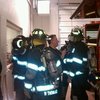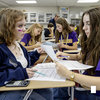VCSD mulls $11.5M project
NEW SCOTLAND — The Voorheesville Board of Education discussed initial proposals for an $11.5 million building project this week, after the district’s facilities committee presented its first preliminary report.
When the board president asked if the recommendations were more of a wish list than a necessity, the superintendent said it was a little of each.
This year, an $8 million public library plan for a new building was soundly defeated. Ultimately, the board asked the committee for more focus.
According to the report, the project will improve the district’s building infrastructure, technological capability, security, and athletic grounds. Major parts of the project would repair the high school’s roof, upgrade technology and utilities, install security systems and replace the district’s boilers. Other parts of the project call for revamping or rebuilding several sports fields and buying a large emergency generator.
At a presentation Monday night, Assistant Superintendent for Business Gregory Diefenbach said a large portion of the project, just over two-thirds of expenses, would be covered by state or federal aid, which might not be as available in coming years.
“We won't have another shot for a long time,” said board trustee and facilities committee member C. James Coffin. “What’s in the package is our best way to address these things. What was most reasonable — other methods were thrown out because of a dramatic impact on taxes.”
If all the committee’s preliminary suggestions in the report were approved, Diefenbach said, a district property owner with a $250,000 home would pay a maximum of $13.13 more a month in school taxes for the next 20 years, which is likely the length of any project bond.
To look at it another way, that same homeowner would pay an average increase of $157.50 per year and about $3,144 over the next two decades for the project.
After the presentation, school board President Timothy Blow and other members said they had a number of questions.
“I have a series of questions,” Blow said, “First, the estimates, some of them seem extraordinarily high. I don’t know, is this a puffed-up worst-case scenario?”
A contractor, whose firm is helping Voorheesville analyze the costs of a potential project, told Blow, “There is a little bit of crystal ball gazing of everything these guys put together. There are guesses in market prices in construction and materials a year from now, when it would actually go out to bid and be built.”
Coffin also noted that, when seeking public approval for a project, it would be much easier to spend less than to seek additional funds through a second district vote. He indicated it was common for school building project estimates to be a little higher than the bare costs to accommodate for any small, unforeseen expenses.
Board member Kristine L. Gravino questioned why the district should spend $390,000 for an emergency generator when it already had one for the school.
Superintendent Teresa Thayer Snyder said Voorheesville was designated as a Red Cross shelter and a new generator would help supply power to victims and emergency operations. However, the school already has a smaller generator to keep its kitchen, lighting, and network powered in emergencies.
The board asked the committee to review the report and make more detailed recommendations about the priority of the projects in the plan.
“When is this a wish list versus this is the kind of thing we really need?” asked Blow.
“I would say it’s a little of each,” responded Snyder.
Diefenbach and Coffin both said the report was a starting point in the project and that everything remained open for discussion.
“We want to get the word out, especially to board members, we’re the ones that’ll have to make a decision on this,” said Coffin of presenting the plan.
“What we’re giving you are our menu choices,” added Diefenbach.
The report prioritized different parts of the project into three groups.
The top recommendations call for replacing the roof of the Clayton A. Bouton High School, along with improving or replacing the building’s masonry, ventilation system, gym, and emergency lighting and temperature controls.
Just the roofing project was estimated to cost up to $2,345,200. Board members have previously discussed the building’s roof, voicing concern over its deterioration.
Other high-priority projects include replacing boilers at each of the schools and installing security systems — including cameras at each. The total cost of approving all priority one projects is estimated to be about $6,607,900.
Second-priority projects include overhauling the secondary school choral room, estimated to cost about $1.3 million. The report also recommends spending another $300,000 on repairing the high school’s ceilings and teacher’s work room; and replacing bus garage windows and each of the schools kitchen equipment.
Third-priority items in the report include purchasing an emergency generator, concessions’ stand, and pole barn — all estimated to cost a combined $877,500.
A fourth category of recommended projects includes expenses relating to the district’s sports fields. The plan offers several options to improve a number of Voorheesville main and less-used fields. The most expensive estimate was to build a new high school baseball field for just shy of a million dollars. Altogether, the field recommendations are estimated at about $2.4 million dollars.
Blow seemed cautious about the field proposals, asking for further information about the costs.
“I don’t know how to say to the community, we have poured millions into satellite fields we really aren’t using that much, so how do I go back and ask for more?” he said.
Upgrades to three satellite fields marked for improvements in the plan are estimated to cost just over $800,000.
The board asked the facilities committee to revisit the plan and present a more focused version, which would include more specific recommendations and possible cost savings from the project. One possible savings, for example, with roof, boiler and building improvements, could mean less spent on electricity and heating.
“I’m sure there will be a lot more of these discussions to come,” said Blow at the end of the presentation.


